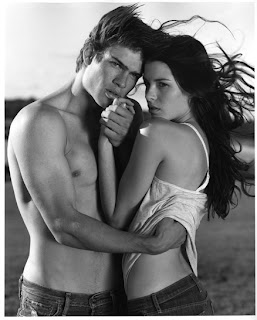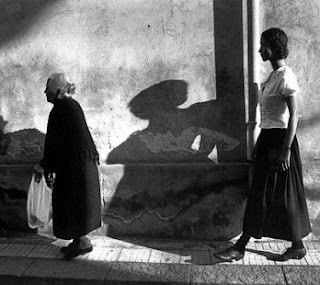Here you can find a lot of different photo galleries
http://www.boston.com/bigpicture/2011/02/libya_unrest_and_uncertainty.html
Saturday, February 26, 2011
Thursday, February 24, 2011
Hyperfocal
Hyperfocal distance is the closest distance at which a lens can be focused and have everything in sight be sharp. In other words, the hyperfocal indicates the distance with the largest depth of field that will remain in focus. When a lens is focused at this distance, all of the objects at distances from half of the hyperfocal distance to infinity will be sharp.
Here is an example:

Phoebe
Here is an example:

Phoebe
Wednesday, February 23, 2011
EO Hoppé
I was in London this weekend and had the opportunity to see a wonderful exhibition of E.O. Hoppe's photographs:
I loved many of the portraits he took of famous people such as Henry James, Kipling and Masefield. There was also a section dedicated to fascinating photographs of London life in the 1920s. He not only liked taking pictures of famous people, but also ordinary people like maids and street vendors. He captured ordinary working men and women throughout his career as he travelled throughout the world.
Some background info:
Emil Otto Hoppé (14 April 1878 – 9 December 1972) was a German-born British portrait, travel, and topographic photographer active between 1907 and 1945. Born into a wealthy family in Munich, he moved to London in 1900 originally to train as a financier, but took up photography and rapidly achieved great success.
-rola
Tuesday, February 22, 2011
REMIND!! Largo dei Fiorentini
The lesson (feb the 23th) is taking place at Largo dei FIorentini.
Cross the river and walk towards Corso Vittorio Emanuele. Before the bridge turn right
There is only one building there.
Ask information to the front office.
Cross the river and walk towards Corso Vittorio Emanuele. Before the bridge turn right
There is only one building there.
Ask information to the front office.
Wednesday, February 16, 2011
BOOK IDEAS
Themes for the book.
For next week bring some photos that somehow fit in some of these themes.
Just so we have something to work with.
Themes:
Geometry
People (ambient)
Light
Landscape
Friendship (travel, social)
Movement (sports, action)
At work
Abstract
For next week bring some photos that somehow fit in some of these themes.
Just so we have something to work with.
Themes:
Geometry
People (ambient)
Light
Landscape
Friendship (travel, social)
Movement (sports, action)
At work
Abstract
Wednesday, February 9, 2011
Surfers
I find this photograph interesting because of the shadows. The people appear to be much longer than they are.The spacing between everyone is also good allowing for the viewer to appreciate the entire photograph.
Lily
Lily
Exploring E.U.R.
As recommended, I went to EUR and explored the modern architecture of the neighborhood. The most notable building was the square colosseum. Here is a photograph I took of it. To see more of my work you can check out my website: www.phoebepundyk.com (The work on my website does not include anything from this semester in Rome yet)
Phoebe
Bruce Weber & Thomas Ruff
Bruce Weber
Bruce Weber is an American fashion photographer and occasional filmmaker. He is most widely known for his ad campaigns forCalvin Klein, Ralph Lauren, Pirelli, Abercrombie & Fitch, Revlon, and Gianni Versace, as well as his work for Vogue, GQ, Vanity Fair, Elle, Life, Interview, and Rolling Stone magazines.
Bruce Weber is an American fashion photographer and occasional filmmaker. He is most widely known for his ad campaigns forCalvin Klein, Ralph Lauren, Pirelli, Abercrombie & Fitch, Revlon, and Gianni Versace, as well as his work for Vogue, GQ, Vanity Fair, Elle, Life, Interview, and Rolling Stone magazines.
Thomas Ruff
His initial focus was the interiors of German living quarters, with typical features of the 1950s to 1970s. This was followed by similar views of buildings and portraits of friends and acquaintances. These are typically shown with emotionless expressions, in very large, high-resolution passport-style portraits.
Tuesday, February 8, 2011
Andrea Ruggeri
Tomorrow february 9th
the italian photographer Andrea Ruggeri is going to talk about his photograpy work from 2:15 to 3:15 pm
In class
the italian photographer Andrea Ruggeri is going to talk about his photograpy work from 2:15 to 3:15 pm
In class
Wednesday, February 2, 2011
Friedlander and Basilico
Friedlander is an American photographer from the 1960s and 1970s who primarily worked with Leica 35mm cameras producing black and white photos. His largest body of work is of urban ‘social landscapes’. His photos are in an urban setting and include pieces of stores, buildings, posters, and street and signs giving clues to the environment. I like this photograph of Friedlander’s because of the graphic, linear elements created from the signs and their shadows. The vertical lines of the poles break up the strong horizon line.
Gabriele Basilico is an Italian documentary photographer who takes pictures of industrial landscapes and architecture. In 1984 and 1985 he was commissioned by the government to document the transformation of today’s national landscape in various European countries. He has a similar style and artistic intention as Friedlander, however they are working on different continents. Basilico has captured the precise elements of industrial machinery and his work captures the shadows and linear characteristics.
-Phoebe
Pixels
Pictures are made up of little dots called pixels. The picture is made with enough of them together arranged horizontally and vertically.
If you get close to an image or use a magnifier you'll see them.

The picture of the left gives you the example on how you could see an image with a magnifier glass and depending on your distance to the image you'll see it clearer.
The same happens with the size. Depending on how big you want your picture, you will need a picture with more Megapixels, therefore if you want a 2.1" x 1.6" picture, you don't need a camera able to take 24 Megapixels or something like that.
Final Print Size Megapixels Image Size on Monitor
2.1" x 1.6" 0.3 640 x 480
4.25" x 3.2" 1.2 1280 x 960
5.3" x 4" 2.0 1600 x 1200
6.8" x 5.1" 3.0 2048 x 1536
10" x 6.5" 5.3 3008 x 1960
10.25" x 6.8" 6.3 3088 x 2056
13.5" x 9" 11.1 4064 x 2704
Here is what we name resolution, which refers to the size of the image that your camera will produce, so if you have e.g. a 2.0 Megapixels camera and you print a picture as a poster, then you will get a print with a lot of big dots as on the left picture showed above.
To figure out the amount of megapixels that will give you, you multiply the dimensions.
For example:
1600 x 1200 = 1.92 million pixels or 1.92 Megapixels. This would commonly be rounded up and referred to as a 2 megapixel camera.
As this amount goes higher, you will notice a much sharper image, so then....more pixels don't mean better quality, everything depends on the size and the distance.
- Nicole
If you get close to an image or use a magnifier you'll see them.
The picture of the left gives you the example on how you could see an image with a magnifier glass and depending on your distance to the image you'll see it clearer.
The same happens with the size. Depending on how big you want your picture, you will need a picture with more Megapixels, therefore if you want a 2.1" x 1.6" picture, you don't need a camera able to take 24 Megapixels or something like that.
Final Print Size Megapixels Image Size on Monitor
2.1" x 1.6" 0.3 640 x 480
4.25" x 3.2" 1.2 1280 x 960
5.3" x 4" 2.0 1600 x 1200
6.8" x 5.1" 3.0 2048 x 1536
10" x 6.5" 5.3 3008 x 1960
10.25" x 6.8" 6.3 3088 x 2056
13.5" x 9" 11.1 4064 x 2704
Here is what we name resolution, which refers to the size of the image that your camera will produce, so if you have e.g. a 2.0 Megapixels camera and you print a picture as a poster, then you will get a print with a lot of big dots as on the left picture showed above.
To figure out the amount of megapixels that will give you, you multiply the dimensions.
For example:
1600 x 1200 = 1.92 million pixels or 1.92 Megapixels. This would commonly be rounded up and referred to as a 2 megapixel camera.
As this amount goes higher, you will notice a much sharper image, so then....more pixels don't mean better quality, everything depends on the size and the distance.
- Nicole
Ferdinando Scianna
This is Rola. Unfortunately I'm laying sick in bed and won't be able to come to class today. I thought to post something about Ferdinando Scianna. I was lucky enough to see some of his photos exhibited in Venice last summer. The one above is one of my favorites. I love the contrasts, shadows and simplicity of this pictures which I think says a lot about life in general as well as about beauty and age.
A little about Scianna:
"He was born in Bagheria, Sicily, in 1943. In 1967, he moved to Milan, where he started to work for the weekly L’Europeo as a photojournalist and special correspondent. He then went to Paris, where he worked 10 years as a correspondent, writing about politics, photography and literature. In 1982, he joined the prestigious Magnum agency, thanks to master photographer Henri Cartier-Bresson. He alternated between reportage, fashion assignments, advertising and portraits, and finally achieved international acclaim, while continuing to work as a journalist." -lavazza.com
P.S:
Can anyone please post or send me Professor Serafino's email address. My email: rollahalabi@gmail.com
I spoke to him about Dropbox last week and I think it would be a great idea if we all use it for sharing photos as well as documentaries about photography. I got some great ones I would love to share with you. If you would post your email addresses I could easily invite you to use dropbox or start sharing a folder with those of you who already have it.
-rola
Light (color) temperature
Light temperature, which is more commonly known as color temperature involves picking the right film or setting your camera to the appropriate setting depending on the type of light present. When a camera takes a picture the "white" in the photograph may be altered depending on the type of temperature that the source of light is distributing. The temperature of the light is measured in Kelvin degrees. For example, if light is over 6000 Kelvin degrees, the white in the photgraph witll appear blue. When the light is below 4800 Kelvin degreees the white will appear yellowish. Meaning that a standard flash is around 5500 Kelvin degrees. In a digital camera, you can set the white balace to a certain fixed temperature. If you for example set it to 3200, you are telling the camera that you want yellowish tones to appear in the photograph.



-bets
-bets
Subscribe to:
Comments (Atom)













